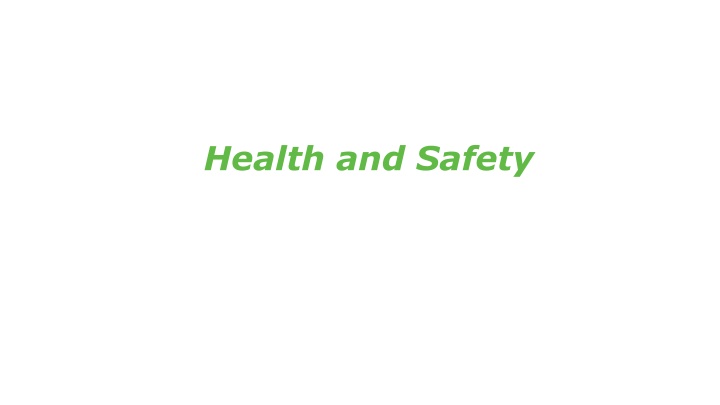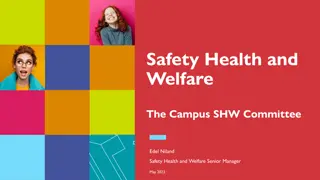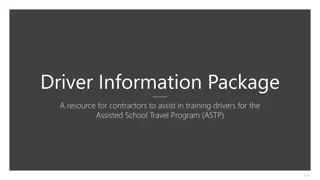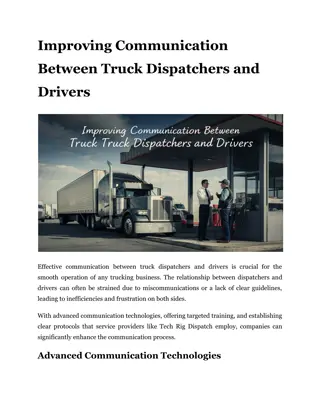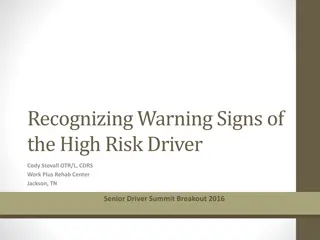Health and Safety Tips for Truck Drivers
Explore essential health and safety information specifically tailored for truck drivers, including mental and physical job demands, workplace hazards, maintaining wellness, rights and obligations, challenges faced, workers' compensation claims, physical job aspects, stress management, healthy eating tips, and staying fit on the road.
Download Presentation

Please find below an Image/Link to download the presentation.
The content on the website is provided AS IS for your information and personal use only. It may not be sold, licensed, or shared on other websites without obtaining consent from the author.If you encounter any issues during the download, it is possible that the publisher has removed the file from their server.
You are allowed to download the files provided on this website for personal or commercial use, subject to the condition that they are used lawfully. All files are the property of their respective owners.
The content on the website is provided AS IS for your information and personal use only. It may not be sold, licensed, or shared on other websites without obtaining consent from the author.
E N D
Presentation Transcript
Unit overview Mental and physical demands of the job Understanding workplace hazards Maintaining health and wellness Your rights and obligations for a safe and healthy workplace 2
Health and wellness challenges A recent survey of 3,500 human resources, recruiting, security, and management professionals found that health issues is a major reason truck drivers leave the industry. (source: Canadian Trucking Alliance) 3
Causes of workers compensation claims Top 10 causes of incidents for drivers in general trucking by number of claims (2012-2016) Rank Cause Claims 1 Overexertion 1153 2 Motor vehicle incident 972 3 Fall from elevation 862 4 Slips & trips (fall on same level) 562 5 Struck by 411 6 Other bodily motion 134 7 Struck against 127 8 Involuntary motion 110 9 Caught in 109 10 Exposure to noise 47 4
Physical aspects of the job Pushing and pulling up/down and two handed Lifting and lowering - up to 24 kg (53 lb.) Carrying - up to 24 kg (53 lb.) for 1.5 6 metres (5 - 20 ft.) Walking, climbing, crouching, neck movements, reaching, elbow and wrist movements 5
Stress 6
Healthy eating and healthy living To avoid the temptation of an oversized fast food meal, drivers should stock their cab s refrigerator with healthy snacks. 7
Tips for healthier eating Eating every three hours helps to maintain stable blood sugar levels. Keep a water bottle in the cab, and stock Perrier or soda water for something bubbly. Cover half your plate with vegetables if you stop at a truck stop food bar. Eat breakfast everyday. Snack on healthy foods. Eat more salad and leafy greens. Drink lots of water. Avoid pop and energy drinks. Don t drink more than two cups of coffee each day 8
Keeping fit What exercises could you do in and around your truck? 9
Truck exercises the Heathy Trucker https://youtu.be/mKMC63ysO9w 10
Falls WorkSafeBC video Arvind s story Meet Arvind: Part-time farmer, long-haul truck driver, hockey dad. Watch what happens when his life takes a bad turn after he falls while exiting the cab of his truck. (3:24) Arvind's Story: Long-Haul Truck Driver Safety https://www.youtube.com/watch?v=1zP1qi8-N_o 11
Three points of contact YouTube video - Three points of contact: Be safe (1:26) https://www.youtube.com/watch?v=bp9TAZhU0FY 12
Ergonomics for truckers Now, let s watch a video from WorkSafeBC identifying things truck drivers can do before they start work to reduce the risk for back injury. (2:43) Ergonomics for Truckers 13
Driver protection devices and equipment Meet Donna: Mom, delivery truck driver, amateur tennis player. Watch what happens when her life takes a bad turn after she s struck by a pry bar while securing a load. Donna's Story: Delivery Truck Driver Safety (3:22) https://www.youtube.com/watch?v=WTGsueqPP3s 15
Your rights The right to know about hazards in the workplace. The right to participate in health and safety activities in the workplace. The right to refuse unsafe work.* *By law, employers are prohibited from penalizing workers for raising a health and safety issue. You can learn more about the actions workers can take if they feel this has occurred at WorkSafeBC.com. 16
Your responsibilities Report hazards immediately to your supervisor or employer. Follow safe work procedures and act safely in the workplace at all times. Properly use the protective clothing, devices, and equipment provided. Co-operate with joint occupational health and safety committees, worker health and safety representatives, WorkSafeBC prevention officers, and anybody with health and safety duties. 17
Your responsibilities continued Get treatment quickly should an injury happen on the job and tell the health care provider that the injury is work-related. Follow the treatment advice of health care providers. Return to work safely after an injury by modifying your duties and not immediately starting with your full, regular responsibilities. Never work under the influence of alcohol, drugs or any other substance, or if you're overly tired. 18
Workplace conflict and violence More than 60,000 workers per day are harassed or are the victims of workplace violence. On a daily basis 43,800 employees are harassed; 16,400 threatened, and 723 workers are attacked. 19
Road rage Small group discussion Part 1 - Has anyone been a victim of road rage? In groups briefly share your story. What did you do? How did it make you feel? Part 2 - In your group read and discuss the information on road rage in your student guide. 20
Aggression management STOP Stop and think before you act. STOP DROP Reduce the intensity of your emotions. PROCESS Think about it. Aggression management PROCESS DROP 21
